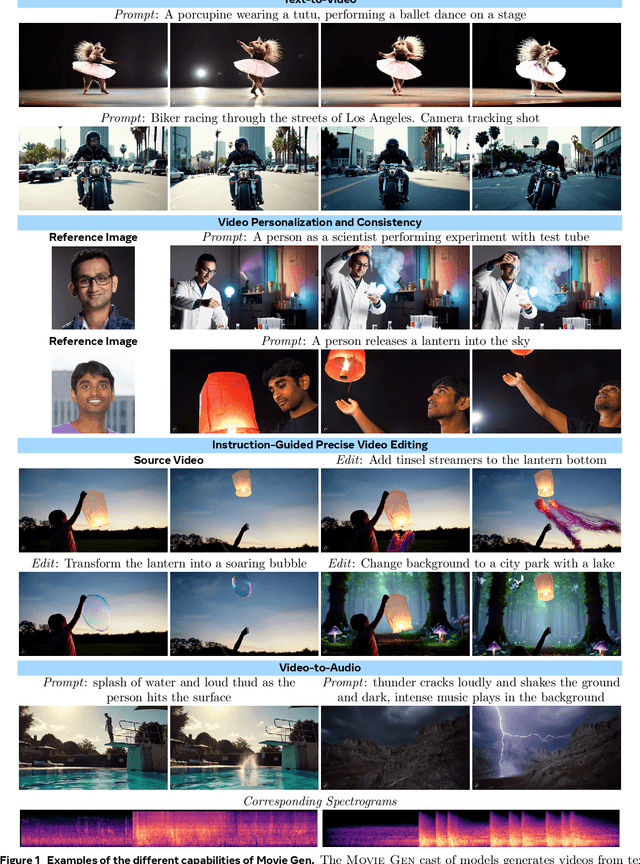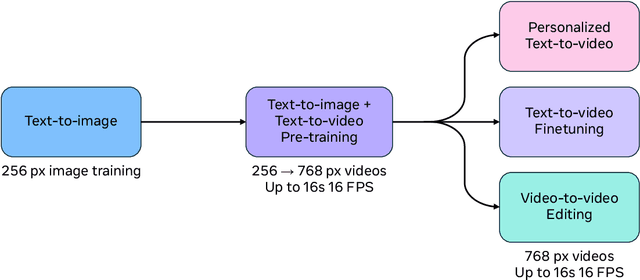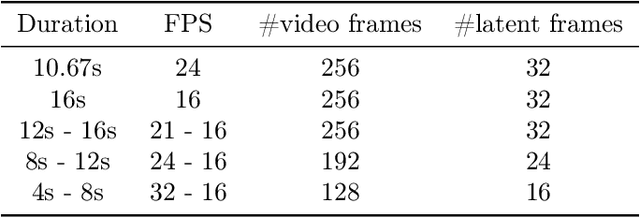Haoyu Ma
MoCha: Towards Movie-Grade Talking Character Synthesis
Mar 30, 2025Abstract:Recent advancements in video generation have achieved impressive motion realism, yet they often overlook character-driven storytelling, a crucial task for automated film, animation generation. We introduce Talking Characters, a more realistic task to generate talking character animations directly from speech and text. Unlike talking head, Talking Characters aims at generating the full portrait of one or more characters beyond the facial region. In this paper, we propose MoCha, the first of its kind to generate talking characters. To ensure precise synchronization between video and speech, we propose a speech-video window attention mechanism that effectively aligns speech and video tokens. To address the scarcity of large-scale speech-labeled video datasets, we introduce a joint training strategy that leverages both speech-labeled and text-labeled video data, significantly improving generalization across diverse character actions. We also design structured prompt templates with character tags, enabling, for the first time, multi-character conversation with turn-based dialogue-allowing AI-generated characters to engage in context-aware conversations with cinematic coherence. Extensive qualitative and quantitative evaluations, including human preference studies and benchmark comparisons, demonstrate that MoCha sets a new standard for AI-generated cinematic storytelling, achieving superior realism, expressiveness, controllability and generalization.
HOIGPT: Learning Long Sequence Hand-Object Interaction with Language Models
Mar 24, 2025Abstract:We introduce HOIGPT, a token-based generative method that unifies 3D hand-object interactions (HOI) perception and generation, offering the first comprehensive solution for captioning and generating high-quality 3D HOI sequences from a diverse range of conditional signals (\eg text, objects, partial sequences). At its core, HOIGPT utilizes a large language model to predict the bidrectional transformation between HOI sequences and natural language descriptions. Given text inputs, HOIGPT generates a sequence of hand and object meshes; given (partial) HOI sequences, HOIGPT generates text descriptions and completes the sequences. To facilitate HOI understanding with a large language model, this paper introduces two key innovations: (1) a novel physically grounded HOI tokenizer, the hand-object decomposed VQ-VAE, for discretizing HOI sequences, and (2) a motion-aware language model trained to process and generate both text and HOI tokens. Extensive experiments demonstrate that HOIGPT sets new state-of-the-art performance on both text generation (+2.01% R Precision) and HOI generation (-2.56 FID) across multiple tasks and benchmarks.
OceanSim: A GPU-Accelerated Underwater Robot Perception Simulation Framework
Mar 03, 2025Abstract:Underwater simulators offer support for building robust underwater perception solutions. Significant work has recently been done to develop new simulators and to advance the performance of existing underwater simulators. Still, there remains room for improvement on physics-based underwater sensor modeling and rendering efficiency. In this paper, we propose OceanSim, a high-fidelity GPU-accelerated underwater simulator to address this research gap. We propose advanced physics-based rendering techniques to reduce the sim-to-real gap for underwater image simulation. We develop OceanSim to fully leverage the computing advantages of GPUs and achieve real-time imaging sonar rendering and fast synthetic data generation. We evaluate the capabilities and realism of OceanSim using real-world data to provide qualitative and quantitative results. The project page for OceanSim is https://umfieldrobotics.github.io/OceanSim.
DirectorLLM for Human-Centric Video Generation
Dec 19, 2024



Abstract:In this paper, we introduce DirectorLLM, a novel video generation model that employs a large language model (LLM) to orchestrate human poses within videos. As foundational text-to-video models rapidly evolve, the demand for high-quality human motion and interaction grows. To address this need and enhance the authenticity of human motions, we extend the LLM from a text generator to a video director and human motion simulator. Utilizing open-source resources from Llama 3, we train the DirectorLLM to generate detailed instructional signals, such as human poses, to guide video generation. This approach offloads the simulation of human motion from the video generator to the LLM, effectively creating informative outlines for human-centric scenes. These signals are used as conditions by the video renderer, facilitating more realistic and prompt-following video generation. As an independent LLM module, it can be applied to different video renderers, including UNet and DiT, with minimal effort. Experiments on automatic evaluation benchmarks and human evaluations show that our model outperforms existing ones in generating videos with higher human motion fidelity, improved prompt faithfulness, and enhanced rendered subject naturalness.
A Mamba Foundation Model for Time Series Forecasting
Nov 05, 2024



Abstract:Time series foundation models have demonstrated strong performance in zero-shot learning, making them well-suited for predicting rapidly evolving patterns in real-world applications where relevant training data are scarce. However, most of these models rely on the Transformer architecture, which incurs quadratic complexity as input length increases. To address this, we introduce TSMamba, a linear-complexity foundation model for time series forecasting built on the Mamba architecture. The model captures temporal dependencies through both forward and backward Mamba encoders, achieving high prediction accuracy. To reduce reliance on large datasets and lower training costs, TSMamba employs a two-stage transfer learning process that leverages pretrained Mamba LLMs, allowing effective time series modeling with a moderate training set. In the first stage, the forward and backward backbones are optimized via patch-wise autoregressive prediction; in the second stage, the model trains a prediction head and refines other components for long-term forecasting. While the backbone assumes channel independence to manage varying channel numbers across datasets, a channel-wise compressed attention module is introduced to capture cross-channel dependencies during fine-tuning on specific multivariate datasets. Experiments show that TSMamba's zero-shot performance is comparable to state-of-the-art time series foundation models, despite using significantly less training data. It also achieves competitive or superior full-shot performance compared to task-specific prediction models. The code will be made publicly available.
Movie Gen: A Cast of Media Foundation Models
Oct 17, 2024



Abstract:We present Movie Gen, a cast of foundation models that generates high-quality, 1080p HD videos with different aspect ratios and synchronized audio. We also show additional capabilities such as precise instruction-based video editing and generation of personalized videos based on a user's image. Our models set a new state-of-the-art on multiple tasks: text-to-video synthesis, video personalization, video editing, video-to-audio generation, and text-to-audio generation. Our largest video generation model is a 30B parameter transformer trained with a maximum context length of 73K video tokens, corresponding to a generated video of 16 seconds at 16 frames-per-second. We show multiple technical innovations and simplifications on the architecture, latent spaces, training objectives and recipes, data curation, evaluation protocols, parallelization techniques, and inference optimizations that allow us to reap the benefits of scaling pre-training data, model size, and training compute for training large scale media generation models. We hope this paper helps the research community to accelerate progress and innovation in media generation models. All videos from this paper are available at https://go.fb.me/MovieGenResearchVideos.
MaskINT: Video Editing via Interpolative Non-autoregressive Masked Transformers
Dec 19, 2023



Abstract:Recent advances in generative AI have significantly enhanced image and video editing, particularly in the context of text prompt control. State-of-the-art approaches predominantly rely on diffusion models to accomplish these tasks. However, the computational demands of diffusion-based methods are substantial, often necessitating large-scale paired datasets for training, and therefore challenging the deployment in practical applications. This study addresses this challenge by breaking down the text-based video editing process into two separate stages. In the first stage, we leverage an existing text-to-image diffusion model to simultaneously edit a few keyframes without additional fine-tuning. In the second stage, we introduce an efficient model called MaskINT, which is built on non-autoregressive masked generative transformers and specializes in frame interpolation between the keyframes, benefiting from structural guidance provided by intermediate frames. Our comprehensive set of experiments illustrates the efficacy and efficiency of MaskINT when compared to other diffusion-based methodologies. This research offers a practical solution for text-based video editing and showcases the potential of non-autoregressive masked generative transformers in this domain.
Instance Tracking in 3D Scenes from Egocentric Videos
Dec 07, 2023



Abstract:Egocentric sensors such as AR/VR devices capture human-object interactions and offer the potential to provide task-assistance by recalling 3D locations of objects of interest in the surrounding environment. This capability requires instance tracking in real-world 3D scenes from egocentric videos (IT3DEgo). We explore this problem by first introducing a new benchmark dataset, consisting of RGB and depth videos, per-frame camera pose, and instance-level annotations in both 2D camera and 3D world coordinates. We present an evaluation protocol which evaluates tracking performance in 3D coordinates with two settings for enrolling instances to track: (1) single-view online enrollment where an instance is specified on-the-fly based on the human wearer's interactions. and (2) multi-view pre-enrollment where images of an instance to be tracked are stored in memory ahead of time. To address IT3DEgo, we first re-purpose methods from relevant areas, e.g., single object tracking (SOT) -- running SOT methods to track instances in 2D frames and lifting them to 3D using camera pose and depth. We also present a simple method that leverages pretrained segmentation and detection models to generate proposals from RGB frames and match proposals with enrolled instance images. Perhaps surprisingly, our extensive experiments show that our method (with no finetuning) significantly outperforms SOT-based approaches. We conclude by arguing that the problem of egocentric instance tracking is made easier by leveraging camera pose and using a 3D allocentric (world) coordinate representation.
CVTHead: One-shot Controllable Head Avatar with Vertex-feature Transformer
Nov 11, 2023Abstract:Reconstructing personalized animatable head avatars has significant implications in the fields of AR/VR. Existing methods for achieving explicit face control of 3D Morphable Models (3DMM) typically rely on multi-view images or videos of a single subject, making the reconstruction process complex. Additionally, the traditional rendering pipeline is time-consuming, limiting real-time animation possibilities. In this paper, we introduce CVTHead, a novel approach that generates controllable neural head avatars from a single reference image using point-based neural rendering. CVTHead considers the sparse vertices of mesh as the point set and employs the proposed Vertex-feature Transformer to learn local feature descriptors for each vertex. This enables the modeling of long-range dependencies among all the vertices. Experimental results on the VoxCeleb dataset demonstrate that CVTHead achieves comparable performance to state-of-the-art graphics-based methods. Moreover, it enables efficient rendering of novel human heads with various expressions, head poses, and camera views. These attributes can be explicitly controlled using the coefficients of 3DMMs, facilitating versatile and realistic animation in real-time scenarios.
Harmony World Models: Boosting Sample Efficiency for Model-based Reinforcement Learning
Sep 30, 2023Abstract:Model-based reinforcement learning (MBRL) holds the promise of sample-efficient learning by utilizing a world model, which models how the environment works and typically encompasses components for two tasks: observation modeling and reward modeling. In this paper, through a dedicated empirical investigation, we gain a deeper understanding of the role each task plays in world models and uncover the overlooked potential of more efficient MBRL by harmonizing the interference between observation and reward modeling. Our key insight is that while prevalent approaches of explicit MBRL attempt to restore abundant details of the environment through observation models, it is difficult due to the environment's complexity and limited model capacity. On the other hand, reward models, while dominating in implicit MBRL and adept at learning task-centric dynamics, are inadequate for sample-efficient learning without richer learning signals. Capitalizing on these insights and discoveries, we propose a simple yet effective method, Harmony World Models (HarmonyWM), that introduces a lightweight harmonizer to maintain a dynamic equilibrium between the two tasks in world model learning. Our experiments on three visual control domains show that the base MBRL method equipped with HarmonyWM gains 10%-55% absolute performance boosts.
 Add to Chrome
Add to Chrome Add to Firefox
Add to Firefox Add to Edge
Add to Edge